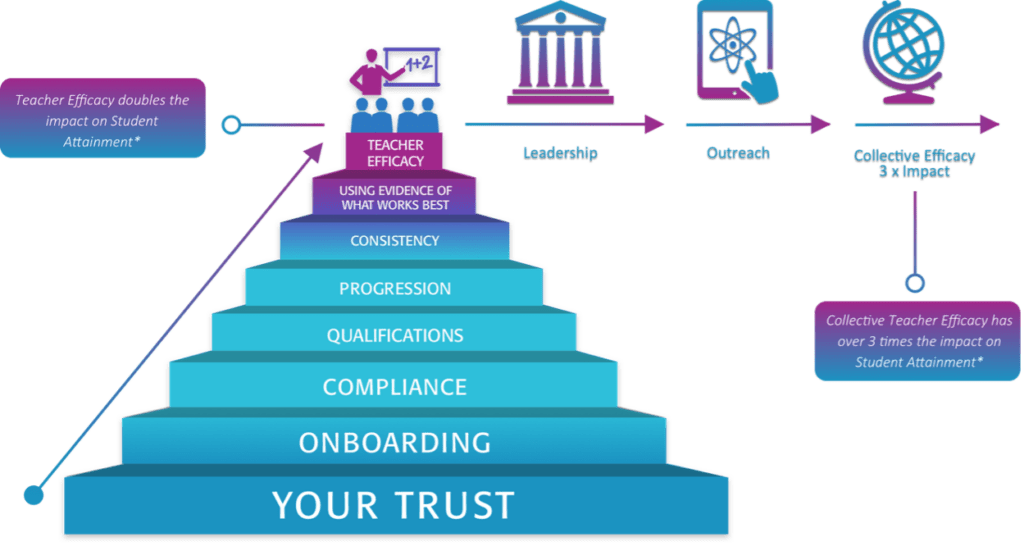
In this long read, Dr Fiona Aubrey-Smith offers practical advice on how to ensure that the professional learning in your school is the ‘very best it can be‘
We are now half way through this academic year and, yet again, our wonderful school staff have worked tirelessly through some really challenging circumstances to make children’s learning the very best it can be. School leaders will be asking themselves how they can do the same thing for their staff – how they can make their professional learning the very best it can be. Fortunately, we can draw on a superb synthesis of research evidence curated by the Teacher Development Trust about teachers’ professional learning which recommends that it should;
- be sustained, and with a regular rhythm of support over a period of two terms or longer;
- be based upon teacher’s own experience, needs and vision of what their children’s success looks like;
- include opportunities to discuss with peers – and ‘more knowledgeable others’ – the theory, practice and testing of new ideas, to see practice expertly modelled and to receive expert feedback on their own efforts;
- be clear and explicit on the intended impact on children’s learning.
Few of us would disagree with any of the points above but, in a busy school environment with lots of different staff needs to attend to, how do we turn this evidence-based guidance into practical action? As part of my research work with a number of trusts facing this challenge I have observed some key themes to successful professional learning provision. These can be summarised through the 7 Es which I’d like to share with you here – they may be useful to you in your own school or trust.

ENLIST
Which children are facing challenges and barriers in their learning that need to be addressed? For example, white working class boys in writing fiction, children in Class X in mathematical word problem-solving, at-risk children with social confidence needs.
This is the ‘be clear and explicit on the intended impact on children’s learning’ advice from the research evidence.
Which people are best placed to support these children? This could be experienced staff with the relevant knowledge and skills, or staff who are at the right stage in their careers to develop this knowledge and these skills, and are ready for talent-development.
This is part one of the ‘be clear on the teacher’s own needs and experience’ advice from the research evidence.
ENGAGE
Before signing staff up to courses – how much do you know about that teacher’s own vision of what children’s success looks like?
This is part two of the ‘be clear on the teacher’s own vision’ advice.
My top tip here is not to assume that even your longest-serving or most aligned teacher is necessarily totally as one with your school vision and ethos for teaching and learning (a very common mistake). Evidence shows that ‘consciously we teach what we know; unconsciously we teach who we are’ (Hamachek, 1999). Moreover, in education we are very good at giving the answers we think people want to hear. To unpack more about your individual teachers’ visions around teaching and learning, try using the Pedagogy Framework as a conversational prompt.
In unpacking what your individual teachers think about teaching and learning – their pedagogical stance – you will probably surface a number of different ideas about how to address the needs of your focus children (see ENLIST, above). You will need to engage staff in professional discussion about which of these is most appropriate in your specific school, by whom, with whom, and how – drawing out very explicit needs and actions.
This ensures that you are ‘clear and explicit on the intended impact on children’s learning’ in relation to the specific teachers who will be engaging in the professional learning;different teachers will create different kinds of impact – so this is really important (Aubrey-Smith, 2020).
ENACT
It is likely that you will have multiple strands of conversation going once you reach the ENGAGE stage above. These will result in the enacting of a number of different types of professional learning across your staff – meeting the needs of those at different stages of their careers, with different strengths and passions, and across different subjects, phases and areas of expertise. It is helpful to think of all of these strands knitting together as a sort of pyramid (see below) that you are all climbing together.
Staff across your trust will move through onboarding training, complete their compliance training and relevant qualifications (whether ITE, ECF, NPQs, leadership or specialist qualifications). Once these solid foundations are in place we can create progression across professional learning – moving all staff on in the same way that we do with all children.
But…and I cannot emphasis this enough…we must understand our individual teachers better – what their personal pedagogical views are and why; this makes a huge difference to the way they interpret professional learning inputs and interventions and, ultimately, their application into practice and impact on children’s experiences and outcomes. When all of our staff are moving forward on their own professional learning journey we can then start to see improved teacher efficacy – which involves their self-belief in their own capabilities and the direct relationship between their actions and children’s outcomes

ENHANCE
As your staff undertake the range of professional learning activities that you have identified they will begin to explore new ideas about theory and practice; this is the ‘sweet spot’ where you need to provide them with opportunities to discuss with a ‘more knowledgeable other’ (remember Vygotsky and the importance of social dialogue within learning to extend us just beyond where we might otherwise reach!)
This builds upon the advice above about teachers testing ideas, seeing practices expertly modelled and receiving of expert feedback on their own efforts. Importantly, they should be encouraged to discuss and challenge their thinking about both theory and practice – something we don’t do enough of as a profession; we tend to focus predominantly on practice, which is a bit like eating a chocolate cake and wondering why it tastes strange without looking to see if it contains sugar!
This phase is where coaching comes into its own – whether using in-school expert peers, online coaches as part of course provision, or through external or formal coaching programmes. The discussion is an absolutely integral part of ensuring that the professional learning makes an impact – on both your teacher and your children. Both matter. It is also absolutely vital that EVALUATION is woven throughout – keeping a very tight focus on that most basic of questions, ‘So what?’
For every idea or discussion encourage all staff to be asking themselves, ‘So what?’ What difference does it make to the child/children? Importantly, really focus staff thinking objectively on what the evidence shows as making a difference – this is not about what mightmake a difference, or justifying plans and actions. Often teachers (and leaders) can be desperate to show that an idea worked in order to justify the time and energy spent on it (to themselves, as well as to you). However, it doesn’t matter if something hasn’t worked because we can learn from that; the important thing is reflecting on why, recalibrating our thoughts and ideas with new evidence and understanding, and then moving on to what that evidence suggests will work better.
This is what moves us from ‘What evidence shows works’ to ‘What evidence shows works best’
EXCEL and EXTEND
When staff have experienced the kinds of professional learning outlined above, they build confidence as well as capability; this means they can then become that ‘more knowledgeable other’ to staff across your school or trust – as well as offering expertise to the wider teaching profession – which is, as is increasingly argued, an important component of ethical leadership.
Encourage your staff to be thinking about where they could take this new competence and confidence, and how might it affect their career development or aspirations. How can they play an integral part in school succession-and-sustainability planning so that your investment of time and energy in their development benefits the wider school or trust in the longer term? This could be about retention, and building new kinds of roles for staff that impact upon increasingly wider numbers of children, but it could also be about recruitment – reflecting your school or trust as a place that invests in growing teachers as learners just as much as growing children as learners.
Last, but definitely not least, you will be reading this article as someone interested in developing professional learning in others but please don’t forget your own professional learning. Go back through the 7 Es, above, and consider how many of these are in place for you? More importantly, what will you do next in order to move from ‘What this evidence is telling you’, to ‘What the evidence now shows will work better’?
Dr Fiona Aubrey-Smith is Director of One Life Learning specialising in strategic education research and consultancy. She is also an associate lecturer at The Open University, a founding fellow of the Chartered College of Teaching and sits on the board of a number of multi-academy and charitable trusts. Fiona is a regular contributor to books, panels and papers about pedagogy and education technology. @FionaAS


Be the first to comment